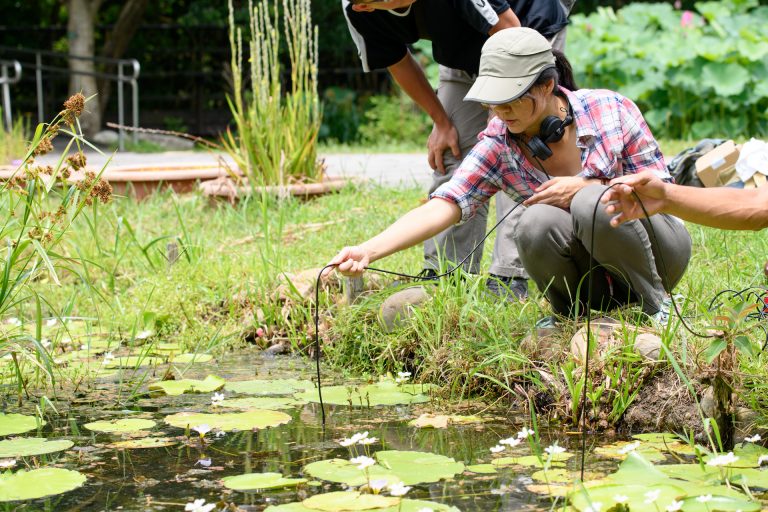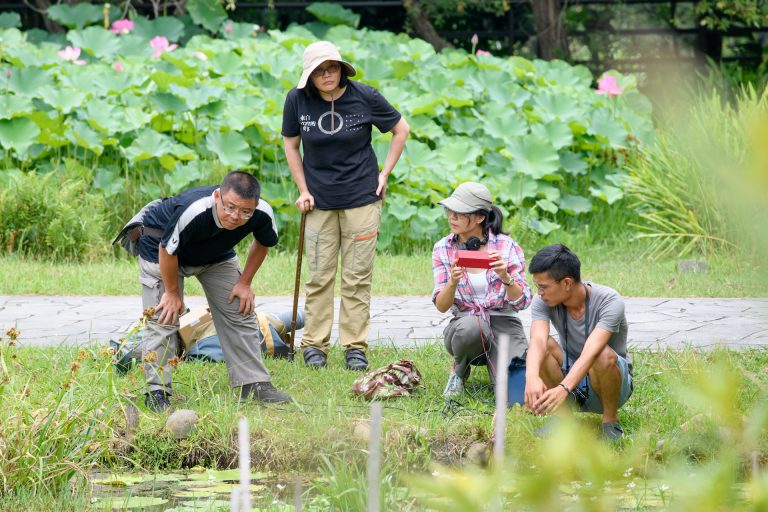身兼野地錄音師、作家、節目製作主持人、紀錄片編導、協會理事長等多重身分的范欽慧,長期推動聲音環境教育,以不同領域的跨界合作,積極投身於聲景(Soundscape)觀念在臺灣的推廣與探索。受訪過程中,她始終溫和而堅定地闡述理念,從自身的生命經驗出發,也不吝於分享聆聽的箇中趣味。
談及生物的聲音多樣性,她親自模仿起不同國家的鳥類「口音」:臺灣小鶯的長短音、日本樹鶯的嘰嘰喳喳,乃至於中國地區有些誇張的捲舌音。語畢,我們都笑了。「音質一樣,語言不同。」她這麼形容。然而,為何會想要探詢及記錄這些多樣性,她道出信念在於「想要讓每個人都能聽出其中的不同,越多人能聽出來不是更好嗎?這不應該是只有我的權利啊!」
時間回到1997年,當時剛離開上一份工作的范欽慧自問:人生中最想做的事情是什麼?「我想進到森林裡,光用耳朵聽,就知道那些鳥的名字;我想認識臺灣的植物和動物;我想知道這片土地在每個季節裡,都會發生什麼事情。」她明白自己需要創造出一個身分,才能去做她真正想做的事,就這樣,范欽慧成了一名廣播電台主持人與獨立製作人,進行以自然生態為主軸的環境教育,也對於東奔西跑的田野工作樂在其中。她買來錄音機、麥克風等設備,將每一集都當成「聲音紀錄片」來製作,節目裡一段關於毒蛇的十分鐘報導,可能需要跑去工寮待上兩天;要做昆蟲的調查,或許也得走進深山野地,回來再去錄音室處理採集到的聲音。三個月後,她的節目《自然筆記》獲得了教育電台史上第一座廣播金鐘獎。
節目至今21年來沒有間斷,范欽慧的身分也不停有所轉變。由於工作機緣認識到太多精采的故事,因此在製作廣播節目以外,她也寫文章和拍紀錄片,作品屢屢獲獎;孩子出生以後轉換跑道,從一位四處奔波的田野工作者,變成一位親子旅遊達人,甚至出版書籍分享經驗,過程中也還能持續在野外錄音。「廣播對我來說是一個基底,讓我生命當中所有的相遇,都成為了我的伙伴。它像苔蘚一樣,如此繽紛,又可以自體演化得很好。我覺得那是最偉大的植物。」如今孩子長大了,范欽慧又回到自己喜愛的田野工作,致力於環境教育並尋求更多可能性。
 對於田野工作樂在其中的范欽慧,致力於環境教育並尋求更多可能性。圖/王世邦攝影
對於田野工作樂在其中的范欽慧,致力於環境教育並尋求更多可能性。圖/王世邦攝影
數年前,范欽慧受到美國自然錄音師戈登.漢普頓(Gordon Hempton)的著作《一平方英寸的寂靜》(One Square Inch of Silence: One Man’s Search for Natural Silence in a Noisy World)所啟發,了解到自己身為一位錄音師,是可以用行動促成環境的改變。她也意識到問題在於,人們往往因為不善於聆聽,無法體會自然聲音的美好,所以不懂得大自然這種「生命的寂靜」的保存價值。她寫信向漢普頓道謝,沒想到很快就收到回覆,要求她寄一顆臺灣的石頭過去,與漢普頓用來宣示要捍衛寂靜的石頭,一同擺放在奧林匹克國家公園的霍河雨林。范欽慧寄出她在東部、源自中央山脈河流的河床上所撿拾的一顆石頭,那裡是多年來她收錄自然聲景覺得最棒的地點。兩個遙遠之地的相同願景就這麼巧妙地被聯繫在一起。幾次書信往返後,漢普頓決定將石頭寄回到范欽慧手裡,告訴她「寂靜即將回家」(Silence will come home)。
這顆石頭後來被命名為「寂靜許願石」,它承載了所有關於寂靜的心願。因為記錄了太多故事,它所「聽過」的聲音成為象徵介面,而後傳遞下去,走向人群。這件事創造了一個新的、關於聆聽的文化,它從文化的本體長出來,同時又與世界和人們自己密切相關。范欽慧開始認真傾聽石頭帶來的聲音,帶著它走訪世界各地,遠赴義大利參與海底生物聲學研討會、前往日本感受音之風景等等未曾接觸的領域,將這些訊息都帶回臺灣,以《搶救寂靜》一書回顧自己長年蒐集與探索自然聲音的經驗,也用不同觀點帶領讀者認識聲音。同時,她也向羅東林區管理處提出「寂靜山徑」的構想,希望在太平山的翠峰湖畔設計一條以「聆聽」為目標的步道,邀請人們前來安靜地聆聽這裡的聲音。在林務局的支持下,經過多年的奔走與努力,這項目標也終於在2018年得以完成。
在搶救寂靜之時,范欽慧也體認到聆聽庶民生活與文化環境聲景同等重要,「臺灣可以是一個善於聆聽的島嶼,明明充滿吵雜的聲音,卻有這麼多層次的聆聽美學和文化,得以展現與兼容並蓄。甚至呢,以我們的聆聽美學去影響全世界,這是我要的目標。」秉持這樣的精神,她運用先前的相遇與結緣,決定實現一項更大的願景,要以組織的力量,展演臺灣多樣化的自然與人文聲景。
2015年,毫無前例可循,范欽慧憑著一股天真的衝勁,義無反顧地創立了「台灣聲景協會」,或許也是世上第一個由公民力量發起,以聲音為核心的環保組織。然而,要以協會作為平台推廣個人對聲景研究的理念,就需要更多人理解以聲學為基礎的環境關懷共識。於是協會成員不只是生物聲學、聲場量測的研究者,也包含音樂藝術、文史研究、社區參與等領域的專家,在多方想像的碰撞下激盪出全新火花,透過舉辦講座、聆聽導覽、聲音採集等活動,帶領都市居民學習「如何聆聽」。因此台灣聲景協會不只是一個任務編制,還是一個聚集了不同創造者的虛擬平台,促成社會演進的推動力量。
創了一個協會以後,范欽慧自認就像是在照顧一個孩子,它可以做些什麼事情,完全不是她生命經驗的原有脈絡可以掌握。協會成立至今第四年,一切都還處於演變之中,運作經費大多來自親朋好友或善心人士的捐款,也曾經對外招募志工,有人看了她的書受到感召,對自然環境與聲音產生新的想法,便選擇留下幫忙。范欽慧表示,目前已有越來越多年輕人主動與協會接觸,他們帶著各自的命題前來,尋找值得自己努力的方向,而聲景替他們開啟了不一樣的想像和視野,也串聯起更多故事。她只有一個單純的信念,即「需要比廣播節目更大的平台來凝聚、展現這個力量。」透過與新世代合作的機會,她感受到傳承的重要性,也因此急於將聲景文字化或圖像化,同時致力尋求更多跨領域的合作機會,以便人們能更快地與之接軌。
 台灣聲景協會集結了不同領域的成員投入聲景研究,近年來也有越來越多年輕人主動前來接觸。圖/王世邦攝影
台灣聲景協會集結了不同領域的成員投入聲景研究,近年來也有越來越多年輕人主動前來接觸。圖/王世邦攝影
「住在竹林路的人,現在能聽見的幾乎只剩下摩托車聲。但是回溯這塊土地的命名由來,它過去應該要有什麼樣的聲音?」范欽慧認為,在當今快速變動的社會,反思人們所處的環境,聽覺時常是人們較忽略的一塊。現代人處在一個空間的時候,往往不是真的處在裡頭,好比拿著手機「抓寶」,人與真實空間的關係其實是斷裂的。然而,光是提供不一樣的聆聽選擇,就可能達成一種聲音記憶的連結與再造,無論是找回竹林裡的原有聲響,或者學會從聲音辨認關渡溼地裡的生物,都能讓人對該地有全新的認識與感受。此外,聲音也具有絕對的在地性質,與土地的連結非常深遠,如同捕撈文蛤的漁民光聽聲音,就能判斷水底下的收獲數量;而原住民聽著風或海,即可成為一種生活相關的提醒。「讓耳朵還留有機會,跟著環境去聆聽。可不可以創造一種氛圍,當人們離開了建築物,還能有一個以環境為家的概念,以及用聲景來串聯地理界線的可能?」
「我從小就喜歡聲音、從小就在錄音。」范欽慧小的時候住在鄉下,那裡的水泥電線杆上有許多孔洞,用來製造階梯以方便維修,每當下雨裡頭就容易淹水。偶然間,她發現只要朝著不同高度的洞丟石頭,就會傳出不同的聲響,因此開始尋找「最好聽」的電線杆,就這樣成為一項獨特的生命記憶。後來,她會專門去一些平常人不會注意到的地方,只為了尋找聲音線索,感受那些情境。「現代人太依賴視覺,越來越沒有這樣的記憶了。如果不去喚醒和聆聽,很多人根本不知道為什麼要聽。」這或許也正說明了,為什麼范欽慧對於「被遺忘的聆聽」如此敏感。每到一個陌生之地,范欽慧都會特別注意聲音的探索,感覺自己全身的細胞專注於聆聽,並且讓她對身處的世界有了不同體會。懂得聆聽就能懂得欣賞,提供一個新的角度,去認識本就一直在那裡的事物。這樣的文化普及可以讓空間的意義更加具體,而聆聽的文化素養和生態知識,都是可以透過努力建構出來的。根本上,那其實是一種尊重彼此的態度。
「我很清楚,過去這麼多年來,在大自然錄音的時候,我深深地改變了我自己。」過去的范欽慧也許從來沒想過,今日的自己可以做到這麼多事,「生命當中有很多邀請,有的時候你也不知道你是做出了選擇,或者其實你是被選擇的那一位。」她只是選擇了認真傾聽,專注於自己內心的聲音,聽從那些召喚,並且勇敢承擔!